With the MENOG 15 meeting taking place this week, we look at Internet measurements and statistics for countries in the MENOG region.
Inspired by the MENOG 15 meeting taking place in Dubai this week, we look more closely at the region. What interesting statistics and measurements can we produce for the region as a whole and for individual countries in the region? While the MENOG community is of course open to everyone, for this study we focus on 14 countries in the MENOG region (see Footnote [1] for a list).
Membership statistics
As of 29 March 2015, we counted 832 Local Internet Registries (LIRs) in the MENOG region, which is 7.2% of the total of 11,543 active LIRs currently registered with the RIPE NCC.

The spread of these 832 LIRs over the region is shown in Figure 2. Turkey and Iran show the most RIPE NCC members.
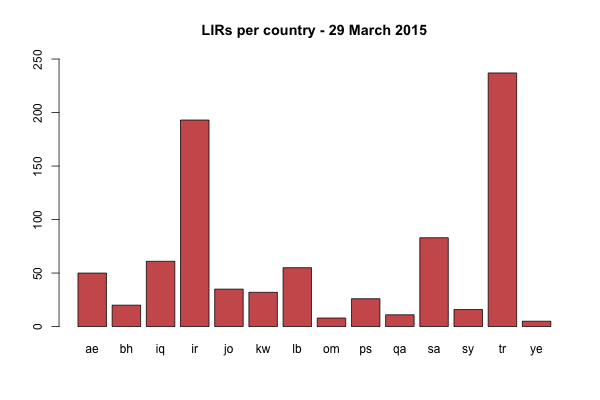
In Figure 3 we look at the number of Autonomous System Numbers (ASNs), IPv4 allocations, IPv4 assignments, IPv6 allocations and IPv6 assignments held by LIRs in the MENOG region. You can see that IPv4 addresses and ASNs are most abundant. IPv6 allocations are a good third. This is, however, not unexpected. LIRs typically filled their addressing needs with IPv4 adresses progressively, with mulitple allocations, as networks grew. With IPv6 on the other hand, a single allocation can fill an LIR's addressing needs for a long time.
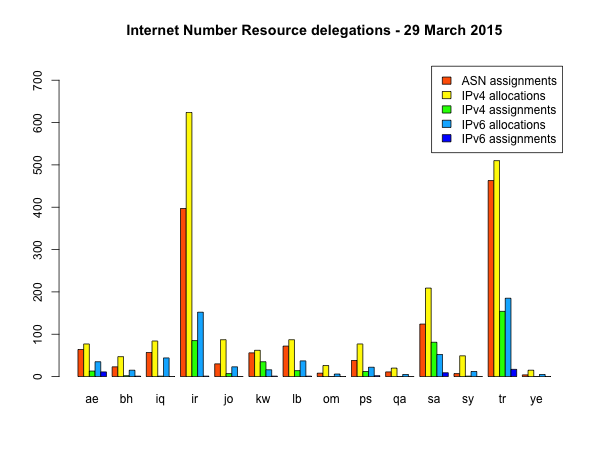
To get an idea how IPv6 deployment in the region is coming along, we look at the IPv6 RIPEness ratings of the LIRs. Figure 4 shows the absolute numbers. For each country, the total height of a bar represents the total number of LIRs based in a country. Within each bar, the coloured segments represent the number of LIRs with zero, one, two, three and four stars in the country. The large majority of LIRs have at least one star, which means they hold IPv6 address space. In absolute terms, Turkey and Saudi Arabia have the most LIRs with a four-star rating.
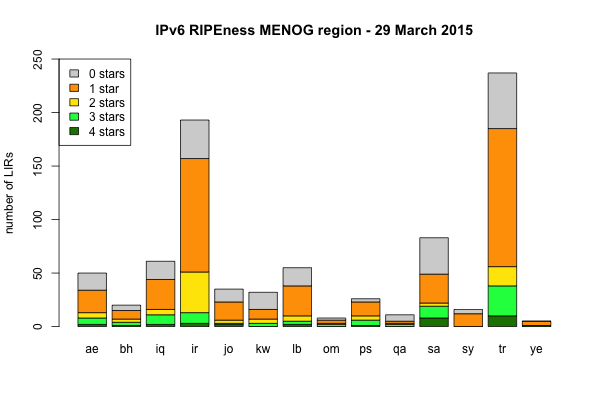
In Figure 5 the IPv6 RIPEness ratings are normalised. The coloured segments now represent the percentages of LIRs with zero, one, two, three and four stars in each country. Saudi Arabia has the highest percentage of four-star LIRs. However, zero- and one-star ratings dominate the graph. This means that, as far as we can measure, most LIRs have not yet done much with respect to IPv6.

Active measurements with RIPE Atlas
We also used our RIPE Atlas measurement infrastructure to look at the same list of countries. We used the same methodology as described in the recent RIPE Labs article Measuring Countries and IXPs Using RIPE Atlas . However, this time we extended it to be able to measure the paths between a set of countries, instead of just within a single country. All the caveats mentioned in that earlier article also apply here.
To get a better idea of the extent of the RIPE Atlas measurement network in these countries, we looked at how many probes are available for these measurements and how many ASNs they cover. To put this into perspective, we also list the number of ASNs that are administratively assigned to that country and are visible in BGP.
| Country | Probes available | ASNs covered by available probes | ASNs visible in BGP |
| IR | 34 | 23 | 320 |
| TR | 26 | 17 | 340 |
| AE | 7 | 3 | 50 |
| IQ | 5 | 5 | 45 |
| QA | 4 | 3 | 9 |
| LB | 4 | 2 | 66 |
| KW | 3 | 3 | 47 |
| SA | 2 | 2 | 108 |
| BH | 1 | 1 | 18 |
Table 1: Overview of RIPE Atlas node distribution in the MENOG region.
For these measurements We didn't have probes available in Jordan, Oman, Palestine, Syria and Yemen. In some of these countries we never had any RIPE Atlas probes, in others there were probes, but unfortunately they are now disconnected or abandoned.
We selected a set of probes based on ASes and geographic diversity as explained in Measuring Countries and IXPs Using RIPE Atlas . In this case we selected at most four probes per AS, which resulted in reducing the number of probes for Turkey by two and the number of probes for Iran by one. For the other countries all available probes were selected. In total our method selected 83 probes for these mesh-traceroute measurements. The results in Figures 6 and 7 make use of this set of probes. Figure 6 shows the geographic paths that we extracted from traceroutes in IPv4. Figure 7 shows the same for IPv6 traceroutes. For all traceroutes the source and destination of the traceroute were in the MENOG region.
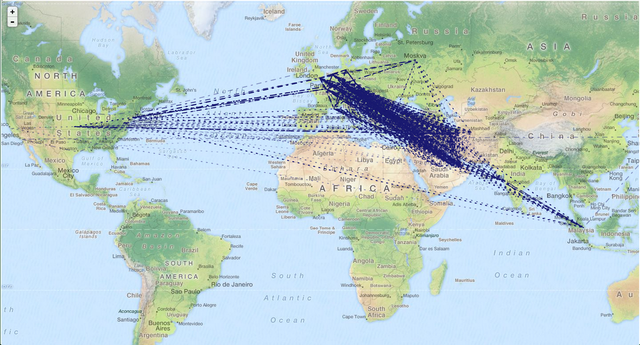
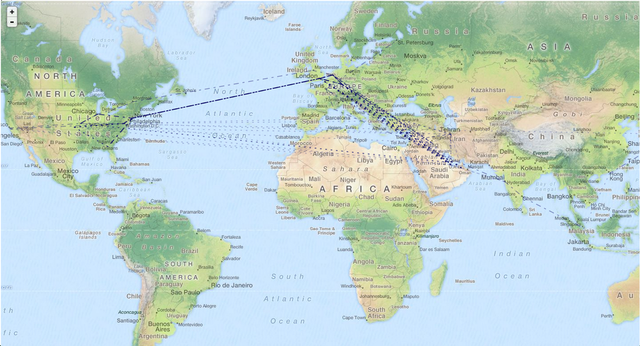
As you can see, for this mesh of paths there are a lot of out-of-region interconnections to Europe, but also routes via India, Singapore and the United States. The IPv6 traceroute mesh was less dense then the IPv4 mesh, but it also shows out-of-region interconnections.
As the paths that we measure are not necessarily the paths were the largest traffic volume flows, some of these might simply be paths that are not economically interesting to optimise.
What is clearly visible is that there are plenty of opportunities to improve latency between ASes in the MENOG region by having them interconnect, or having their upstreams interconnect in the region. Internet Exchange Points (IXPs) can play an important role in this.
In Figure 8 you can see how many of the inter-probe paths actually see IXP peering LANs. We only selected IXP peering LANs in the set of countries that we looked at, and looked in PeeringDB for their peering LANs. That way we found 2 IXPs: UAE-IX in Dubai and SH-IX in Fujairah. We are aware there are more IXPs in the region, but we can't detect them without IXP peering LAN information. As you can see in the Figure below, we only detected IXPs in relatively few of the paths (green). A large number of paths for end-points in the region actually go out of region (red).
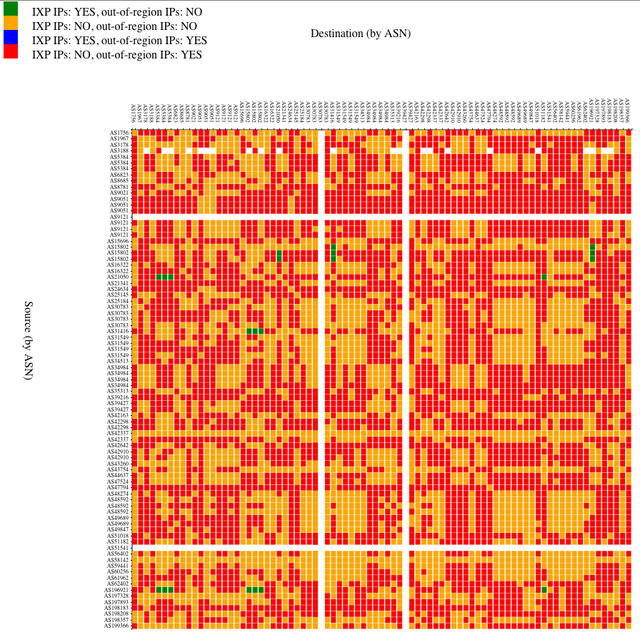
Figure 8: Paths in which we see an IXP in the region (green), paths in which we don't see out-of-region IP addresses (orange), and paths in which we see out-of-region IP addresses (red).
To provide a more accurate picture, we would like to add more RIPE Atlas probes in the region, especially in the ASes that do not yet host RIPE Atlas probes. We would like to encourage people who host probes that are currently offline to get these back online so they can start providing useful data again.
Conclusion
We hope the statistics and measurements we provided here give you additional insights about the Internet in the MENOG region. If you have other things you would like us to look at, please leave your comments below.
Footnote [1]: Countries included in the analysis, and their ISO 3166-1 2 letter codes :
- Bahrain (BH)
- Iran (IR)
- Iraq (IQ)
- Jordan (JO)
- Kuwait (KW)
- Lebanon (LB)
- Oman (OM)
- Palestine (PS)
- Qatar (QA)
- Saudi Arabia (SA)
- Syria (SY)
- Turkey (TR)
- United Arab Emirates (AE)
- Yemen (YE)

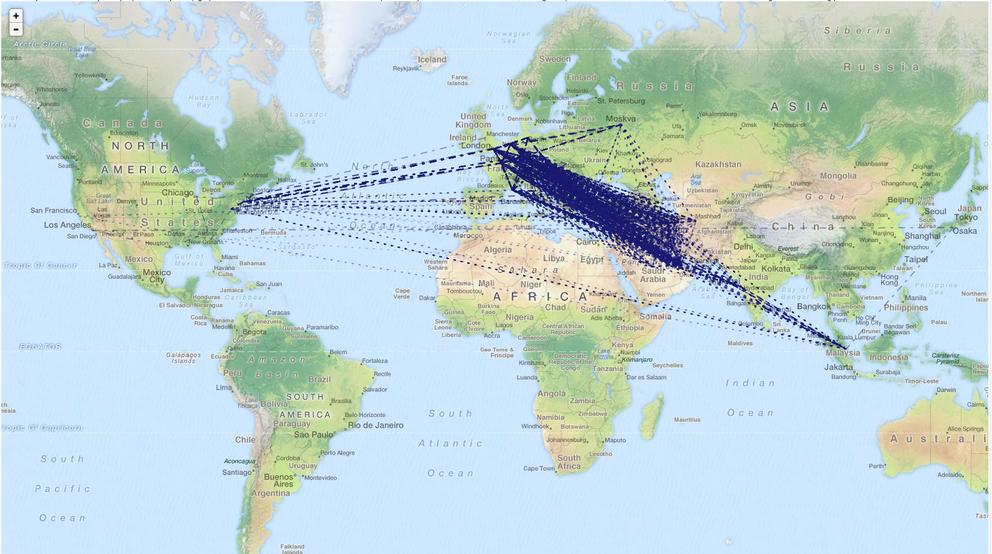



Comments 2
The comments section is closed for articles published more than a year ago. If you'd like to inform us of any issues, please contact us.
Shabib Rizvi •
I wonder how we can encourage the deployment of more probes in the Arabia countries within MENOG?
Michela Galante •
Hi Shabib, Although there are always RIPE NCC staff at MENOG Meetings who give out probes, we are trying to engage more RIPE Atlas ambassadors from these countries. Ambassadors help us distribute probes around the world and represent us at conferences we can't attend - especially those organised locally. Ambassadors can explain RIPE Atlas use cases and give out probes to people who they know will be committed to connecting them. We also run periodic campaigns targeting RIPE NCC members in different regions that have ASNs without any probes connect in them yet. If you have any ideas of your own about how we could deploy more probes in the MENOG region, we would love to hear from you! You can contact us at mcb@ripe.net